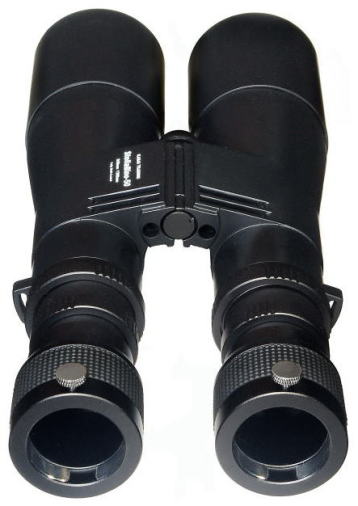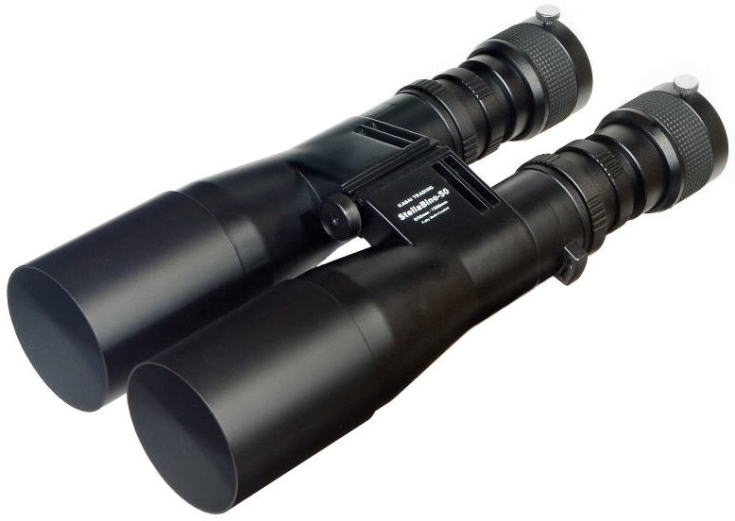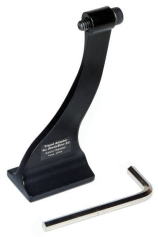| <Development Concept> |
Ordinary binoculars are originally designed for terrestrial viewings. Of
course, they can also be used for astronomical observations, but this is
merely a "repurposed" use, and therefore "erect image"
is always an absolute requirement. However, in order to obtain this erect
image, multiple prisms must be incorporated, which inevitably lead to deterioration
of image quality and loss of light. Furthermore, the size of the prisms
also limits the field of view. For example, in the case of typical 50mm
binoculars, it is physically impossible to secure a FOV of over 7 regardless
of the magnification. (Of course, there are some models that incorporate
huge prisms to achieve an ultra-wide field of view, but they are generally
very heavy, large, and extremely expensive.) Furthermore, the fixed magnification
is also inconvenient. The eyepieces are also built into the housing, so
it is no easy to attach filters.
On the other hand, astronomical telescopes generally produce inverted images,
and it is well known that this is to maintain and maximize the performance
of the objective lenses. Most astronomers are familiar with inverted images
from using telescopes, so the factor of "erect image" is not
always necessary as long as it is specialized for astronomical observations.
Rather, the benefits (sharpness, wide field of view, brightness, etc.)
gained by discarding this factor are far greater. While, the facts that
the eyepieces can be switched, the magnification can be easily changed,
no FOV restriction, and filters can be freely attached, are all major advantages
and indispensable factors for astronomical observations.
Considering these points, the starting point of the development of this device was "to create a pair of binoculars dedicated to astronomical observations that maintains the convenience and operability of binoculars while being equipped with the functions of an astronomical telescope." After several years of conception and multiple prototypes, we were finally able to produce and sell this device. |
|
| <Optics> |
 |
| High-precision 50mm f/4 doublet achromat objective lenses are designed
and manufactured for astronomical use. Full broadband multi-coating achieves
high transmission rate as 99.5%. Unlike normal binocular objective lenses,
very sharp and clear iamges can be maintained up to a high magnification
range of 20-30x. Chromatic aberration is also well corrected, and is suppressed
to a level that is almost unnoticeable at magnification ranges within the
practical range for deep-sky observaton use. Combined with a simple structure
without prisms, clearer image quality that is far superior to that of ordinary
50mm binoculars can be obtained. |
| <Focusers> |
| Butter-smooth rotary helical focusers are equipped. The focusing operation
is the same as IF binoculars, familiar for any binocular users.16mm travel
and 8mm maximum backfocus can reach the infinity focus with most eyepieces.
Low profile fastening screws with metal compression rings for the 1.25"
eyepieice adapters can secure good centering retention, holding eyepieces
reliably and accurately. |
|
| <Overall Designs & Features> |
| The unique design combines a binoculars-like form that fits comfortably
in hands, and the basic functions and features required of an astronomical
telescope, with the assumption that it will be hand-held. 50mm long objective
dewcaps reliably block stray lights even when observing in bright surroundings.
The inside of the dewcaps and the main tubes are completely anti-reflection
matt black painted. In addition, the insides of the tubes are equipped
with baffle rings similar to those of ordinary refractors, which eliminate
internal reflections and greatly contribute to improving the image contrast.
The connection between both the main tubes is an orthodox folding type,
so you can adjust the interpupillary distance with the same operation feel
as with normal binoculars. Of course, a threaded hole for attaching a tripod
adapter is equipped in front of the central axis, and if you use a tripod
adapter (optional), it can be mounted on a photographic tripod, etc. Holes
for the neck strap (included) are also provided on the left and right sides. |
<Eccentric-Rings Collimation Function>
|
| StellaBino-50 is always shipped with well pre-collimated state, but, as
is the fate of binocular telescopes with interchangeable eyepieces, the
perfectly collimated state may not always be maintained during actual use.
For example, when using heavy and/or large eyepieces, the eyepiece adapter
parts may bend slightly, causing a slightly misalignment. In order to make
it easy for users to solve this problem, collimation functions are equipped
on both the tubes. This structure is generally called an "eccentric-rings
collimation mechanism," a method of connecting two slightly eccentric
rings and rotating both of them appropriately to adjust the collimation
state of both the tubes. Normally it's installed inside the objenctive
lens cell, and no easy for users to adjust them. However, in StellaBino-50,
these mechanisms are equipped between the main tubes and the eyepiece adapters
so that users can access these functions and adjust the collimation state
easily whenever necessary. |
NOTICE: Each unit of StellaBino-50 is well pre-collimated before shipment,
so there is no need for re-adjustment under normal use.
Please use this function only when necessary. |
| <General Aptitude> |
| StellaBino-50 is a unique pair of binocular telescopes made "only" for astronomy enthusiasts. The eyepieces can be changed, so you can freely choose the magnification and FOV. You can also use filters freely. There is no FOV limitaton by prisms. Even with two normal eyepieces, the total weight is less than 1kg, so it can be used easily by hand-held. And, the greatest feature is that the simple structure without prisms provides a very bright, clear, and sharp image quality. Please enjoy the splended deep-sky views with your both eyes with eye-opening clarity. |
|
|


